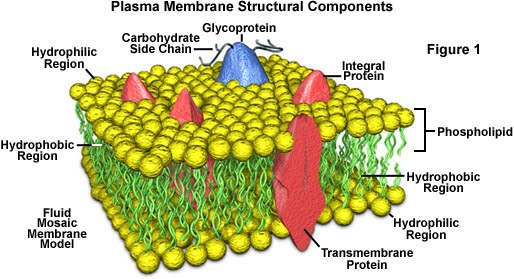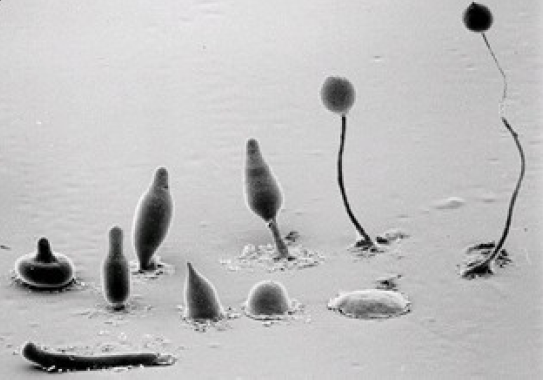17. Cells: Self-Organizing Systems of Life
Definitions
Symbiosis — the association of two or more organisms of different species that are interdependent and where each gains benefits from the other.
Serial Endosymbiosis Theory (SET) — the theory that complex cells emerged from fusions of different kinds of bacteria.
Amphiphilic molecules — molecules that have one end which attracts water molecules and the other end which attracts oil molecules.
Organelles — small structures within cells that perform specialized beneficial functions. The following are two examples of organelles:
Mitochondria — small bodies within all cells, except bacteria, which contain their own DNA and enzymes. They use oxygen and store chemical energy in the form of adenosine triphosphate (ATP) which is used by the cells.
Plastids — small bodies within plant cells. They can act as storage bodies or, when they contain chlorophyll, become the site of photosynthesis.
Background
One of the enduring surprises of biology is the fact that all living organisms (with the exceptions of viruses, bacteria and single celled organisms) are made up of multiple copies of the same unit of structure. From whale to ant, from human to oak tree, the basic structural unit is the cell. The human body is made up of about a million, million (1012) cells. Cells average about 12/1000th of a millimeter in diameter and are remarkably complex. They all have some common internal structures such as, a round nucleus containing chromosomes. They have cytoplasm with mitochondria, and other organelles for producing proteins, lipids, and enzymes of staggering variety.
The most important function of all cells is the conversion of outside energy to energy for all living activities. It is this energy conversion which enables the cell to organize itself, to produce and repair its own parts and then to power cell division that results in copies of itself.
Discussion
Basic cell theory says that cells come from cells but says nothing about how cells began. The question of the self-organization of the first cell is perhaps the most nagging unanswered question in biology. In order for cells to form in the first place, the substances of which they are made must somehow be held together and kept from diffusing into the environment.
The self-organization of the cell membrane
A group of chemicals in a solution are always being dissipated by diffusion and thermal mixing. When the first membrane formed and enclosed a chemical mix, living cells became possible. The structure of cell membranes is now known to be composed of lipid molecules. These are members of a class called amphiphilic molecules, longish molecules with chemically active ends. One end is hydrophilic and is attracted to water molecules. The other end is lipophilic (hydrophobic). It has an oil-like structure and it repels water molecules.
In an aqueous environment a group of amphiphilic molecules will turn their water-loving ends toward the water molecules while their water-repellent oil-like ends tend to attach together. They form into a two molecule thick layer with heads out on both sides and tails inward. It has been shown that a plane of such a bilayer can collapse into a sphere. The amphiphilic molecules tend to organize themselves into a hollow ball with their oily center layer providing a water barrier. The products of chemical reactions that take place inside such a hollow ball are protected from diffusion. Products can be concentrated within it. In living cells this double layer membrane has large protein molecules imbedded in it that act as pores and allow materials in and out of the cell.

Source: micro.magnet.fsu.edu
The behavior of the membrane is due to its structure. The “head” of amphiphilic molecules is electromagnetically asymmetric. Water molecules are also electromagnetically asymmetrical and these two asymmetries attract one another. On the other hand, oil molecules are electrically symmetrical and so are the “tails” of the amphiphilic molecules. This gives them an oily property and accounts for their attraction to each other rather than to water molecules. It is these properties of amphiphilic molecules that makes possible a new structure – the cell membrane: the essential element for a living cell.
The self-organization of complex cells
For more than half of the total history of living organisms on Earth, some two billion years, the main character was the relatively simple prokaryotic cell. These bacteria, with their genetic material composed of one long strand of floating DNA, are still the most successful of living self-organizing systems. The big evolutionary jump to eukaryotic cells with a closed nucleus containing up to a thousand times as much DNA as the prokaryotic cell and with many other complex organelles was, until recently, one of the great mysteries of biology.
Lynn Margulis of the University of Massachusetts has been the prime mover of serial endosymbiosis theory (SET). This theory, for years ignored but now generally accepted, holds that eukaryotic cells emerged from prokaryotic bacteria by a multistage symbiotic fusion of different kinds of free-living bacteria. Bacteria that could use oxygen in their respiration became the mitochondria. The plastids of plant cells are descendants of phototrophic bacteria that use light energy to produce carbohydrates. And spirochetes that have a whiplike structure which enables them to move became the undulipodia (waving feet) or cilia of some cells.
As SET gained credibility the narrow view that the evolution of species was solely the work of natural selection operating on random mutations expanded to include mergers as a means of producing new forms of living systems. Further studies may lend support to the idea that symbiosis may be a more important source of evolutionary novelty on the cellular level than genetic mutations.
Let me remind the reader that if symbiosis is an important process in evolution we must say that understanding self organization is vital to understanding the beginning of life..
The self-organization of the embryo
Surely one of the most fascinating examples of selforganization is the development of a single fertilized egg into a complex, multicellular organism composed of dozens of different kinds of cells with hundreds of adaptive structures and thousands of different metabolic processes and behaviors. Although much remains to be learned, the notion of concentration gradients is helping biologists to understand this process. Concentration gradients are the differences in concentration produced when chemicals diffuse into an environment — from maximum at the place of origination to minimum at the edges of the diffusion.
From studies with the long-suffering genetic laboratory animal, the fruit fly Drosophila, researchers have confirmed the existence of morphogenetic (changes in inherited structures) gradients that control the development of the larva. For example, the concentration of a protein called bicoid is strongest at the head end of the egg. Bicoid activates a gene for head and thorax development. If bicoid is transferred to the rear pole of a normal egg the embryo develops a duplicate head where the abdomen should be. In the normal egg the initial Bicoid gradient is established by special nurse cells which deposit mRNA for bicoid on the head tip of the unfertilized egg while it is developing.
Another control protein has been found in Drosophila. It is called dorsal and stimulates the dorsal/ventral pattern in the larva. When the concentration is altered the front and back development of the fly is misdirected. The abnormal organisms produced when these chemical gradients are changed serve as proof that gradients are the mechanisms that control normal development.
Independent cells self-organize for social benefits
Algae cells - cooperation for reproduction
The ancient blue-green algae reproduce asexually. But before any one of them begins to bud they first assemble into groups. The experience of being in among others in some way seems to provide a necessary chemical or physical stimulus for reproduction. (Reported in Science Times, The New York Times, April 30, 1996)
Bacteria - cooperation for movement
An unnamed rod bacillus without cilia has been observed to lie unmoving on a nutrient agar surface until cell division has increased its numbers to 10 or 12. The assembled group, resembling a raft of floating logs, acquires the ability to move across the surface. The property of locomotion arises from their interaction. It may be that the production of a coat of slime is necessary for movement and that the threshold amount required needs the cooperative efforts of a group.
By assimilating nutrients and reproducing as they raft along, the numbers increase until hundreds of thousands are joined in a moving colony. Presumably, this behavior would assist the colony to find a new source of food. (Personal observations – 1996)
Bacteria - cooperation for protection
Recent researches have reported a “social life” for bacteria. What is described as a new field of biology is the study of bacterial group behavior. The common Escherichia coli and other bacteria seem to be able to communicate with each other and act together.
Masses of bacteria, when exposed to noxious stimuli, bunch up into tight balls that form “fantastic geometric patterns” on agar surfaces in petri dishes. Researchers at Harvard University have discovered that when the bacteria are exposed to hydrogen peroxide or antibiotics they secrete amino acids. The secretion induces the bacteria to aggregate into tight little balls. While the outer bacteria may die, those inside the balls are protected and survive.
James Shapiro of the University of Chicago, whose laboratory has been studying this kind of bacterial behavior for many years is quoted as saying, “For 300 years or more, scientists have searched for the simplest unit that they could take apart, dissect and use to study the system. But we are entering a period in which, in some cases, we have come to the limit of that approach, We need to understand more about how the properties of the whole arise. We are searching for new principles." (Reported in Science Times, The New York Times, Oct. 13, 1992)
Social amoeba - cooperation for movement and reproduction
Before we leave the topic of cells as self-organizing systems the truly remarkable soil amoeba Dictyostelium discoideum should be mentioned. It is a good example of the beginnings of multicellular organization. Because of its unique life cycle, it has been extensively studied and can be grown in the classroom to illustrate a selforganized cellular system.
The life cycle is separated into three distinct stages. At first individual amoeba grow and reproduce by simple cell division on the forest floor. When the bacteria on which the Dictyostelium feed are exhausted in the area thousands of cells aggregate in response to an emitted chemical signal and form themselves into a slug-like creature, just visible to the naked eye, With feeding at an end the individual amoeba become part of a multi-cellar organism that moves as one body to another location.
The slug-like aggregate organism releases a layer of slime on which it glides. The slime trail is in part responsible for Dictyostelium's common name “slime mold.” When the movement stops, the cells differentiate and form a stalk structure with a round spore case on top. When many slugs form the stalk structure the mass looks like a mold. Each of the spores contains a living cell which, when it falls onto a suitable surface, will open and new amoeba will emerge and initiate another life cycle.

There is nothing more wonderful to contemplate than the selforganization of living systems; in particular the union of complex egg and complex sperm to the most complex structure known, the human brain. With Darwin we reflect that... ”There is grandeur in this view of life”